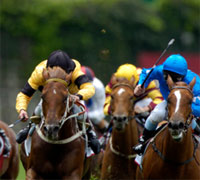
Catastrophic injuries still plague the horse racing industry. This was clearly evident when Eight Belles fractured both front fetlock joints after finishing second in the 2008 Kentucky Derby and was euthanized. Fortunately, the amount of research to date has led to considerable advances in preventing, diagnosing and treating injuries to racehorses. The challenge is to apply this information practically to prevent horses from fracturing their limbs.
Catastrophic injury occurs in approximately two horses out of 1,000 horses that start in races, while less severe injuries that require medical treatment are more common. Fortunately, the equine research community and equine clinicians have determined many of the causes and underlying risks for these injuries, thereby improving the treatment for these elite equine athletes. The industry is on the verge of making significant headway in implementing these findings on a daily basis.
Reasons for fractures
Although catastrophic injuries gain the most attention, most fractures do not result in catastrophic injury and are routinely repaired due to advancements in fracture and joint repair. Several factors lead to the relatively high incidence of fracture in racehorses:
- Cumulative amount of work at high speed of a horse while training and racing, which can predispose the horse to injury.
- Quality of bone, a condition that also plagues humans. Although osteoporosis has not been thoroughly studied in horses, there is concern that some horses may have weak and brittle bone that is prone to injury.
- Abnormal geometry or shape in joint surface that would place abnormal stresses across joints. Abnormal shape has been correlated to condylar fractures (cannon bone fractures) and may be due to abnormally high stresses within the joint that lead to failure.
- Quality of the racetrack surface – in other words, the stiffness and resistance of the surface. Variation in these qualities can impose different stresses to the limb, some leading to injury.
Each of these factors has been addressed by a considerable amount of research, which to date has been performed with limited resources. Although equine veterinarians have been more productive in preventing and diagnosing fractures through the development of nuclear scintigraphy, digital radiography, magnetic resonance imaging (MRI) and computed tomography (CAT Scan), the practical application of these techniques in the field (namely at tracks and at farms) is still needed. Imaging modalities such as MRI and CAT scans require special equipment only found in veterinary hospitals and require specialized training to operate them.
Practical applications
There has also been considerable research to better characterize the causes of injuries. Studies on bone microdamage, joint shape, track surface qualities, epidemiologic factors (studies of various traits such as breed, age, sex, racetrack, etc.) that lead to fracture and computerized modeling (used to determine the amount of stress within tendons, bones and joints) have all been performed. Now that we have a better understanding of the cause of injuries, the industry must improve practical applications of this information to prevent bone fractures.
For instance, because recent evidence has shown that the shape of a joint plays a role in the incidence of fracture, the abnormal shape of a joint must be occurring during growth and development. Therefore, improved monitoring and use of imaging techniques are needed to try and maximize normal limb conformation and shape in foals. Once these methods are developed, farm managers and veterinarians can better monitor foals during growth.
Racetrack monitoring and further research on how a horse moves is also desperately needed to help understand the role of the track surface in leading to injury. Inertial sensor technology has improved significantly and can be used to measure the movement of the horse’s limbs and also the amount of force with which they strike the ground. This technology can be used during training to monitor limb use, and help to identify any abnormal limb movement that may be an early indicator of injury.
Abnormalities in bone quality have also been characterized at the biochemical and molecular level, and genetic and biochemical marker techniques. Biomarkers measured in blood samples have been characterized in horses and show promise to monitor changes that might predispose a horse to injury. In addition, further research to develop imaging techniques such as standing computed tomography and magnetic resonance imaging is needed to make them more practical. If standing techniques can be maximized and used at the racetrack, horses predisposed to injury can be identified before injury occurs. To further research to develop these techniques, industry partners are needed to develop and commercialize these practical techniques.
Overall, great advances have been made in understanding the causes of injury in racehorses, and some practical methods have been developed to identify horses that may be predisposed to injury. Research to date has answered some of the questions, but more research is needed to allow stall-side application of techniques that potentially can be used daily to maximize safety for racehorses.
By Christopher E. Kawcak, DVM, PhD, DACVS, Professor, Orthopaedic Research Center, College of Veterinary Medicine and Biomedical Sciences, Colorado State University, and Iron Rose Ranch Chair in Musculoskeletal Research.






Interesting.
interesting facts
One way to help prevent fractures would be to let the horses mature before running them. They’re just babies!